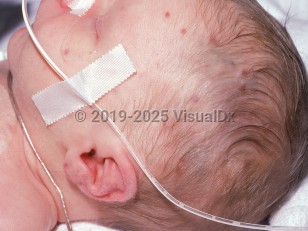Congenital rubella
Alerts and Notices
Important News & Links
Synopsis

Congenital rubella (German measles) is caused by maternal rubella virus infection, typically during the first trimester. Rubella is a togavirus RNA virus. The disease is rare in the United States due to mandated vaccination.
Congenital rubella infections result in the most severe manifestations when acquired in the first 3 months of gestation. These can range from miscarriage or stillbirth to severe fetal malformations. Patients with classic early acquired congenital rubella commonly have eye findings including congenital cataracts, pigmentary retinopathy, and glaucoma. Cardiac manifestations may include patent ductus arteriosus and peripheral pulmonary arterial stenosis. Hepatosplenomegaly and jaundice may also be found. Sensorineural hearing loss (often unilateral) is a common feature and may be present at birth or manifest in the first few years of life. Microcephaly, meningoencephalitis, and developmental delays may also be seen. Radiolucent bones may also be observed on x-ray. Dermatologic manifestations usually present within the first 24 hours of life and include purpura and skin nodules representing extramedullary hematopoesis.
If rubella is acquired later in gestation, the effects to the fetus are milder and may involve isolated sensorineural hearing loss or even no apparent effects.
Some manifestations of infection can be delayed. Maternal rubella infection commonly results in the emergence of type 1 diabetes in offspring between the ages of 10 and 30 years, along with other autoimmune conditions, such as chronic thyroiditis.
Congenital rubella infections result in the most severe manifestations when acquired in the first 3 months of gestation. These can range from miscarriage or stillbirth to severe fetal malformations. Patients with classic early acquired congenital rubella commonly have eye findings including congenital cataracts, pigmentary retinopathy, and glaucoma. Cardiac manifestations may include patent ductus arteriosus and peripheral pulmonary arterial stenosis. Hepatosplenomegaly and jaundice may also be found. Sensorineural hearing loss (often unilateral) is a common feature and may be present at birth or manifest in the first few years of life. Microcephaly, meningoencephalitis, and developmental delays may also be seen. Radiolucent bones may also be observed on x-ray. Dermatologic manifestations usually present within the first 24 hours of life and include purpura and skin nodules representing extramedullary hematopoesis.
If rubella is acquired later in gestation, the effects to the fetus are milder and may involve isolated sensorineural hearing loss or even no apparent effects.
Some manifestations of infection can be delayed. Maternal rubella infection commonly results in the emergence of type 1 diabetes in offspring between the ages of 10 and 30 years, along with other autoimmune conditions, such as chronic thyroiditis.
Codes
ICD10CM:
P35.0 – Congenital rubella syndrome
SNOMEDCT:
1857005 – Congenital rubella syndrome
P35.0 – Congenital rubella syndrome
SNOMEDCT:
1857005 – Congenital rubella syndrome
Look For
Subscription Required
Diagnostic Pearls
Subscription Required
Differential Diagnosis & Pitfalls

To perform a comparison, select diagnoses from the classic differential
Subscription Required
Best Tests
Subscription Required
Management Pearls
Subscription Required
Therapy
Subscription Required
References
Subscription Required
Last Reviewed:04/20/2021
Last Updated:04/30/2023
Last Updated:04/30/2023
Congenital rubella

